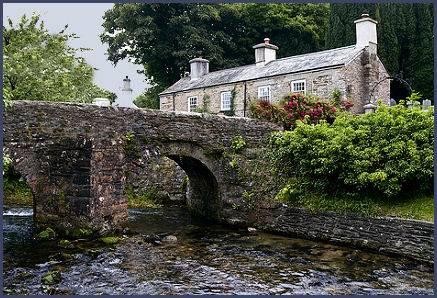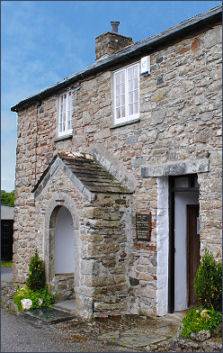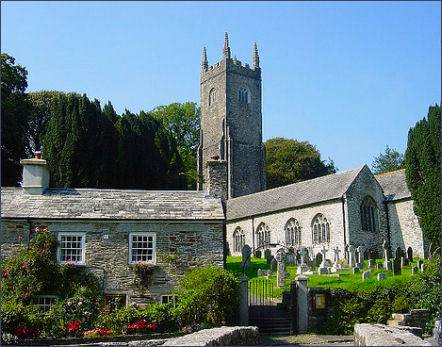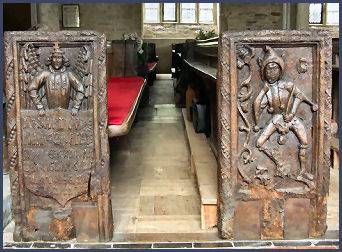Altarnun
OS Grid ref:- SX 2281
 The ancient and picturesque village of Altarnun is situated in the sheltered, wooded valley of Penpont Water on the north-eastern edge of bleak and brooding Bodmin Moor.
The ancient and picturesque village of Altarnun is situated in the sheltered, wooded valley of Penpont Water on the north-eastern edge of bleak and brooding Bodmin Moor.
The village is mentioned in the Domesday Book of 1086 as Penpont and was granted to Robert, Count of Mortain and Earl of Cornwall by his half-brother, William the Conqueror. The village derives its present name, meaning the altar of St. Non, from its church of St. Nonna, which dates back to the fifteenth century. St. Nonna was the mother of St. David, the patron saint of Wales.
The village has a post office, village shop and butchers shop while a characterful fifteenth century stone pack horse bridge crosses the stream.
 The King's Head public house at Five Lanes, was once an old coaching house on the turnpike road across the moor, it dates to the seventeenth century and is reputed to be haunted. The Rising Sun Inn dates back to the sixteenth century and serves locally produced ales and meals in a warm and inviting traditional pub atmosphere. There is also a small campsite next to the inn.
The King's Head public house at Five Lanes, was once an old coaching house on the turnpike road across the moor, it dates to the seventeenth century and is reputed to be haunted. The Rising Sun Inn dates back to the sixteenth century and serves locally produced ales and meals in a warm and inviting traditional pub atmosphere. There is also a small campsite next to the inn.
The Old Rectory in the village was once visited by the authoress Daphne du Maurier and is featured in her famous novel 'Jamaica Inn', the building dates to 1842. The Poor Houses, a long white cottage which faces the pretty village green, dates from the early nineteenth century, it was run by the parish overseer of the poor until it was sold in 1871. It now serves as a private house.
The Georgian meeting house boasts a carved effigy of John Wesley, which is visible above the door,and is the work of the local sculptor Nevil Barnard (1818 - 1878). Wesley stayed at the cottage of Digory and Elizabeth Isbel (right) in Trewint near Altarnun when preaching in the area, In 1950 the Isbell house and the Wesley rooms were suitably restored and opened to the public. The Wesley Cottage now provides a unique visitor experience set in an eighteenth century Cottage and Chapel which is thought to be the smallest Methodist Preaching place in the world. It contains many interesting items of Wesleyana.
Alatarnun features in Daphne du Maurier's famous novel Jamaica Inn, set in former coaching house by the same name at the nearby village of Bolventor.
The Nine stones of Altarnun, sometimes known as Altarnun stone circle, is situated in an isolated location on open moorland around 3 kilometres (1.9 miles) south southeast of the village. The stone circle is the smallest on Bodmin Moor, measuring only 49 feet (15 metres) in diameter and consists of eight granite stones. The nearby Goodaver Stone Circle is situated near Bolventor. The circle has 24 of its original stones remaining and dates from the Bronze Age . Some restoration of the site was carried out in 1906 when some of the stones were incorrectly repositioned.
The church of St. Nonna
 Altarnun's most impressive building is its church, built of unquarried granite from the moor, the present building was constructed in the fifteenth century and replaced a twelfth century Norman church which previously occupied the site.
Altarnun's most impressive building is its church, built of unquarried granite from the moor, the present building was constructed in the fifteenth century and replaced a twelfth century Norman church which previously occupied the site.
Known as the 'Cathedral of the Moors', the church is undoubtedly one of the finest in Cornwall and is mentioned in Simon Jenkin's book 'England's Thousand Best Churches'. The graceful pinacled tower rises to 109 feet and took over a generation to complete.
The Norman font, a portion of a capital in the north wall and the vestry are the only surviving remnants of the original twelfth century church. The impressive font, now situated in the North Aisle by the Screen, was originally painted and features carved bearded faces at its corners with rosettes inbetween. The style of the font is similar to other churches in the Lynher Valley. Only a portion of the fifteenth century Rood Screen today remains standing.
The porch roofs and the wagon roofs of the churches aisles are said to have been salvaged from the Trelawney family mansion in the fifteenth century, the mansion stood around a mile to the north of the church. By tradition the oaks came from the oaks of Trelawney.
St. Nonna's also boasts is a signed collection of 79 bench ends which were carved by Robert Daye between 1510 and 1530, they feature a variety of subjects, including renaissance designs. parish worthies, religious subjects, a jester, a fidler and a man playing the bagpipes.
 The handsome Jacobean altar rails date from 1694 and are the work of John Gard, a Launceston carpenter. The only surviving old glass in the church is the late Medieval fragment in the East Window which depicts St Nonna.
The handsome Jacobean altar rails date from 1694 and are the work of John Gard, a Launceston carpenter. The only surviving old glass in the church is the late Medieval fragment in the East Window which depicts St Nonna.
The fine Celtic Cross situated at the entrance to the churchyard is believed to date from the sixth century, the time of St.Nonna herself. The Welsh St. Nonna was the mother of St. David, the patron saint of Wales.
The Holy Well of St. Nonna stands in a field at a distance of around 300 metres below the vicarage. The well was once thought to have curative properties and in former times served as a bowsening pool, into which the mentally ill were thrown to effect a cure, after immersion into the water, patients were carried into the church for mass.The well was restored by Morley Brown who purchased the land and cleared the water course.
The feast of St. Nonna is celebrated on the second Sunday after Midsummer's Day.